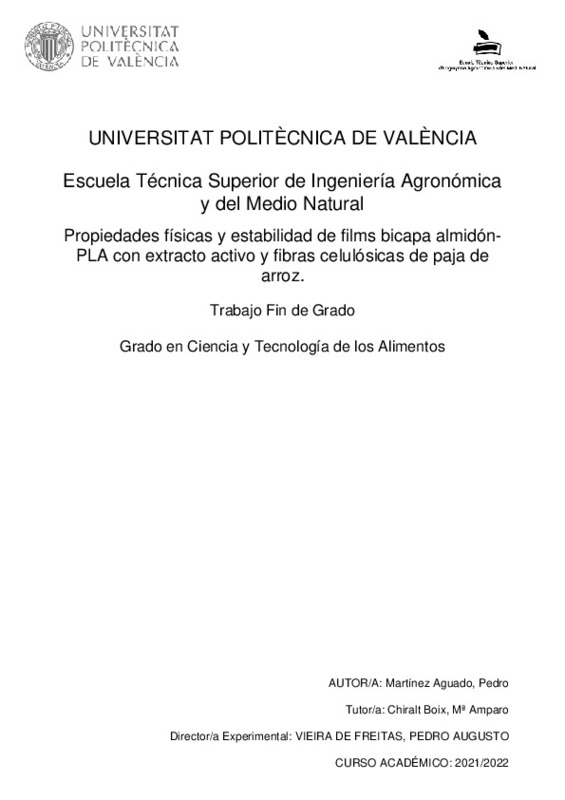|
Resumen:
|
[ES] Se han obtenido y caracterizado films bicapa de almidón de maíz, reforzado o no con 3% de fibras celulósicas de paja de arroz, y PLA con y sin 6% de extracto activo obtenido también de la paja de arroz, con capacidad ...[+]
[ES] Se han obtenido y caracterizado films bicapa de almidón de maíz, reforzado o no con 3% de fibras celulósicas de paja de arroz, y PLA con y sin 6% de extracto activo obtenido también de la paja de arroz, con capacidad antioxidante. Se han caracterizado sus propiedades de barrera al oxígeno y vapor agua, propiedades mecánicas y ópticas a diferentes tiempos de almacenamiento. Se ha analizado la influencia de las fibras y el extracto activo sobre las propiedades de las monocapas, así como sobre las propiedades de las diferentes combinaciones bi-capa. La incorporación de fibras a los films de almidón reforzó su resistencia mecánica y mejoró su capacidad de barrera al vapor de agua y al oxígeno. El extracto activo redujo ligeramente la resistencia mecánica y la extensibilidad a las películas de PLA, pero mejoró su capacidad de barrera al oxígeno. Estas mejoras se reflejaron también en las bicapas, aunque hubo cambios asociados a la migración entre capas de los compuestos de bajo peso molecular presentes en cada una de ellas. Los cambios en las propiedades mecánicas y de barrera ocurridos en los films durante 5 semanas de almacenamiento, revelaron modificaciones estructurales en las matrices poliméricas, que fueron más notables en las capas de almidón, tanto en monocapa, como en bicapas. Estos cambios potenciaron la capacidad de barrera de los films, aumentaron la rigidez y la resistencia a la fractura, pero disminuyeron la extensibilidad, con muy poco impacto en las propiedades ópticas de los films. Las bicapas con propiedades mejoradas, por la incorporación de fracciones de la paja de arroz, tienen un gran potencial para su utilización en el envasado activo sostenible de alimentos, a la vez que permiten la valorización de la paja, produciendo de un material de valor en el mercado.
[-]
[EN] Bilayer films with corn starch films, reinforced or not with 3% cellulosic fibres from rice straw, and
PLA, with and without 6% active extract also obtained from rice straw, with antioxidant capacity,
have been ...[+]
[EN] Bilayer films with corn starch films, reinforced or not with 3% cellulosic fibres from rice straw, and
PLA, with and without 6% active extract also obtained from rice straw, with antioxidant capacity,
have been obtained and characterised. Their oxygen and water vapour barrier properties,
mechanical and optical properties at different storage times have been measured. The influence
of the fibres and the active extract on the properties of the monolayers, as well as on the
properties of the different bi-layer combinations, has been analysed. The addition of fibres to the
starch films enhanced their mechanical strength and improved their barrier capacity to water
vapour and oxygen. The active extract slightly reduced the mechanical strength and extensibility
of PLA films, but improved their oxygen barrier capacity. These improvements were also reflected
in the bilayers, although there were changes associated with the interlayer migration of the low
molecular weight compounds present in each layer. The changes in mechanical and barrier
properties that occurred in the films throughout 5 weeks of storage revealed structural
modifications in the polymeric matrices, which were more noticeable in the starch layers, both in
monolayers and bilayers. These changes enhanced the barrier capacity of the films, increased
their stiffness and resistance to fracture, but decreased their extensibility, with little impact on
their optical properties. The bilayers with improved properties, due to the incorporation of rice
straw fractions, have great potential for use in sustainable active food packaging, while at the
same time allowing for the valorisation of the straw, producing a valuable material on the market.
[-]
|







